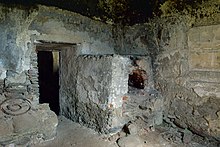Hanfelden Castle

Hanfelden Castle is a 15th century castle in the Unterzeiring district of the Pölstal municipality in Styria .
history
Possibly as early as 1410 the toll leaseholder on the Triebener Tauern , Caspar Han (n) , started building a residence that owes its name to the Hann family . In the middle of the 15th century, Wilhelm Zeller (died 1448) is the owner of the farm. Hans Han d. J. (1450–1516) probably comes from Hans Han d. Ä. who was also a toll leaseholder on the Triebener Tauern. Hans Han d. J. was enfeoffed with the estate by the Roman-German King Maximilian I and began in 1494 with the reconstruction of a desolate court.
A stay of Maximilian I, the last knight, in the castle, or at least in Unterzeiring, is documented for October 1506 by several documents signed there. According to the story, he wanted to reactivate the flooded silver mine in Oberzeiring and is said to have lived in Hanfelden Castle for three months in 1475 in order to monitor the work. A Maximilian room still reminds of it.
The Han (n) family had to sell the castle in 1579 to their relative Hans Rauchberger , who gave the complex its current early Baroque appearance. After the Rauchbergers had to leave the country in 1629 due to their Protestant religious affiliation, ownership of the castle often changed. This meant that it was dilapidated at the beginning of the 18th century. In 1856 the castle was acquired from the Schwarzenberg family by the tradesman Franz Xaver Neuer . His descendants still own the castle today.
The building, which to this day largely presents itself as Georg Matthäus Vischer shows it in his Topographia Ducatus Stiriae in 1681 , has been a listed building since 1965 and, due to its unadulterated, authentic preservation, represents a special architectural and listed jewel. The so-called Maximiliansstube is particularly well-known with the inscription about the king's visit to Zeiring, made around 100 years after Maximilian's visit.
research
Since 2016, the Institute for Prehistory and Historical Archeology (University of Vienna) under the direction of Prof. Claudia Theune in cooperation with the interdisciplinary working group Schloss Hanfelden has carried out archaeological and architectural studies. Current dendrochronological and building history research seem to indicate that the first residential tower may not have been built until around 1500. An older development, as it can be deduced from the written sources, probably refers to a courtyard that was abandoned at that time ('Öder Hof').
Interior
The castle has the only two surviving log chambers in Styria, which are essentially late medieval in their core.
literature
- Martin Aigner,: Building recordings at Hanfelden Castle, Styria , contributions to medieval archeology in Austria 18, Austrian Society for Medieval Archeology, Vienna 2002, pp. 5–20.
- Walter Brunner: St. Oswald-Möderbrugg , Volume 1 - A community and its history, 2002, 682–709.
- Gerhard Reichhalter: Block work chambers from the 13th to 15th centuries from Austrian castles. In: Castle and Function. Austrian Society for Pre- and Protohistory, Vienna 2006, pp. 179–192.
- Robert Fürhacker, Claudia Theune, Interdisciplinary Working Group Schloss Hanfelden: Schloss Hanfelden - Then & Now. Issue 1/2016 and issue 2/2018 Unterzeiring 2016 & 2018 ( issue 1, pdf , univie.ac.at) - detailed construction documentation.
- Melanie Reif: Vive Hanfelden. A contribution to a substance-oriented, preparatory study of the Hanfelden Castle in Unterzeiring (Graz 2016).
- Josef Steiner-Wischenbart: The castles and palaces in the upper Murtal , Graz 1913, pp. 11–15.
Web links
- Entry via Hanfelden Castle to Burgen-Austria
- Hanfelden Castle. In: burgseite.com. Retrieved March 3, 2016 .
- IASH. In: hanfelden.at. Retrieved September 5, 2018 .
- Homepage Theune: Hanfelden Castle. Retrieved October 3, 2018 .
Individual evidence
- ↑ How a tower became a castle. In: Small newspaper. July 29, 2017. Retrieved August 3, 2017 .
- ↑ Hanfelden Castle. In: burgseite.com. Retrieved March 3, 2016 .
- ^ 1. Maximilian Festival in the emperor's former hunting lodge. In: Small newspaper. September 23, 2015, accessed March 3, 2016 .

